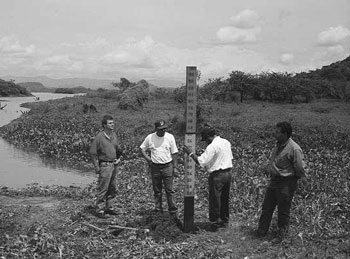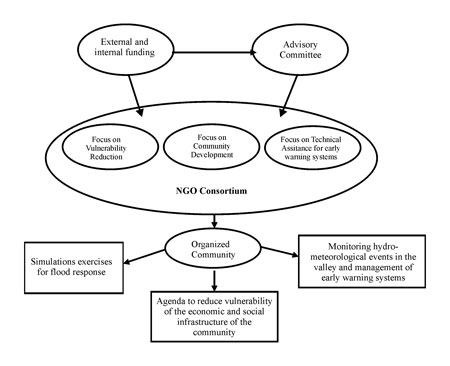|
Flood
Vulnerability Reduction and Early Warning Systems Project for Small River
Basins in Central America now has its own subregional platform
 A
subregional platform has now been established to assist communities in
the implementation of the Flood Vulnerability Reduction and Early Warning
Systems Project for Small River Basins in Central America. A
subregional platform has now been established to assist communities in
the implementation of the Flood Vulnerability Reduction and Early Warning
Systems Project for Small River Basins in Central America.
The Platform will provide training and technical assistance to mostly
poor rural Central American communities so they can play the leading role
in reducing their own vulnerability to flood-related hazards.
An initiative of the Natural Hazards Project of the Organization of American
States’ Unit for Sustainable development and Environment (OAS-USDE),
the Flood Vulnerability Reduction Project facilitates mitigation in river
basin communities that would normally be bypassed by national disaster
reduction policies, since they are located far away from major cities
and do not boast hydroelectric dams or large-scale agro-industrial investments.
The FVR Project also makes it possible for early warning systems to be
set up, and encourages community organization to respond effectively to
water-related hazards. In Honduras, for instance, several pilot interventions
have been successfully carried out that are being duplicated elsewhere.
The interdisciplinary Project, which dates back to 1995, brings together
a variety of institutions from different sectors in order to keep watch
over those atmospheric and meteorological events that, in conjunction
with man-made changes to the environment, are known to cause catastrophic
floods. Long-term climate variations that pose a long-term risk to the
sustainable development of small river basins are also a subject of study
and planning.
Financial support throughout has come from the International Institute
for Infrastructural Hydraulic and Environmental Engineering (IHE), based
in Delft, The Netherlands, which acts as the International Secretariat
of the Dialogue on Water and Climate (DWC). The Central American chapter
of DWC is coordinated by USDE and the Regional Committee on the Water
Resources of the Central American Isthmus (CRRH).
Six stages comprise the Project, all but the last of which have been completed.
Stages One through Five were funded by the European Commission Humanitarian
Office (ECHO) and the government of Ireland. Their focus was on basic
methods for community-centred vulnerability reduction, including pilot
projects in one small river basin in each of the Central American countries
in order to test the validity of these methods. In addition, training
was provided to participating professionals in such fields as vulnerability
assessment, mitigation planning, hydrological analysis, and flood monitoring
and forecasting.
While community involvement
has been a constant of the Project, partly due to a series of awareness-raising
and motivational campaigns, it is only now, with Stage Six and the establishment
of the Subregional Platform, that grassroots participation will kick into
high gear.
So far, two workshops
have been held to promote the involvement of Central American civil society.
The first brought together national, regional and international NGOs,
multilateral and bilateral agencies and local stakeholders to determine
how a consortium of non-governmental organizations—yet to be named—could
assume responsibility for the development of the platform.
The second workshop
defined the structure of the Platform and its plan of action, based on
feedback by the communities themselves on their most pressing needs. The
Platform will involve the following components (see chart below):
- The local communities.
Since it is local communities that are most directly affected by floods
and other natural disasters, the platform will provide them with the
training and technical assistance they need to reduce their vulnerability.
- NGO involvement.
The NGO Consortium that will finally be selected will be responsible
for facilitating vulnerability assessments, maintaining up-to-date risk
maps, developing community education programmes in disaster reduction
and mitigation, and training local residents in community self-management
techniques.
- The Advisory Committee.
The Advisory Committee will include representatives of multilateral
organizations such as the OAS, national emergency commissions, universities
and research institutes, the private sector, NGOs and volunteer groups.
Their job will be to oversee the successful implementation of the Platform
and publicize the results at the international level, as a unique Central
American contribution to global disaster reduction efforts.
- Funding. The Platform
will cover the costs of providing training and technical assistance
for the development of the early warning systems, community emergency
response mechanisms, and vulnerability and mitigation assessments. Participating
communities will cover their own costs, including the maintenance of
the early warning systems once they are in place.
Structure
of the Regional Platform of SVP

Vulnerability reduction
requires significant investments in time and money. Many Central American
communities are willing, even eager, to reduce their vulnerability and
enhance their prospects for sustainable development, but they need training
and technical assistance. It is here that the subregional platform of
the Flood Vulnerability Reduction and Early Warning Systems Project for
Small River Basins in Central America comes in—as a deeply practical
way of improving the quality of life of participating communities while
serving as an example to other developing nations.
For more information,
please contact the Unit for Sustainable development and Environment (OAS-USDE):
1889 F Street NW,
Washington D.C. 20006, USA
+1 (202) 458-6295 – Fax: +1 (202) 458-3560
Natural-Hazards-Project@oas.org
|




